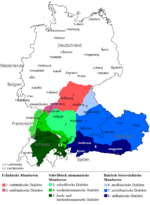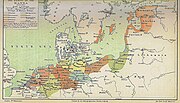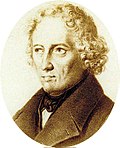Early New High German (ENHG) is a term for the period in the history of the German language generally defined, following Wilhelm Scherer, as the period...
29 KB (2,753 words) - 06:29, 23 November 2024
Early New High German literature refers to literature written in German between the middle of the 14th century and the middle of the 17th. The term Early...
4 KB (336 words) - 18:31, 8 October 2024
The High German languages (German: hochdeutsche Mundarten, i.e. High German dialects), or simply High German (Hochdeutsch [ˈhoːxˌdɔɪ̯t͡ʃ] ) – not to be...
10 KB (892 words) - 00:20, 6 November 2024
New High German (NHG; German: Neuhochdeutsch (Nhdt., Nhd.)) is the term used for the most recent period in the history of the German language, starting...
10 KB (1,021 words) - 01:31, 27 October 2024
of German spoken in the High Middle Ages. It is conventionally dated between 1050 and 1350, developing from Old High German and into Early New High German...
43 KB (3,325 words) - 20:31, 5 November 2024
the Bible into High German was also decisive for the German language and its evolution from Early New High German to modern Standard German. The publication...
142 KB (14,340 words) - 00:40, 24 November 2024
German language begins in the Early Middle Ages with the High German consonant shift. Old High German, Middle High German, and Early New High German span...
14 KB (1,689 words) - 17:18, 8 October 2024
Upper German (German: Oberdeutsch [ˈoːbɐdɔʏtʃ] ) is a family of High German dialects spoken primarily in the southern German-speaking area (Sprachraum)...
29 KB (2,893 words) - 01:28, 21 October 2024
Standard High German (SHG), less precisely Standard German or High German (German: Standardhochdeutsch, Standarddeutsch, Hochdeutsch or, in Switzerland...
41 KB (3,563 words) - 14:10, 21 October 2024
Standard German is a standardized form of High German, developed in the early modern period based on a combination of Central German and Upper German varieties...
23 KB (2,718 words) - 11:59, 26 October 2024
The Middle High German period is conventionally taken to end in 1350, while the Early New High German is taken to begin with the German Renaissance,...
28 KB (3,124 words) - 15:56, 16 November 2024
located within the modern German state of Saxony-Anhalt), the progression of the Reformation would divide the German states among new religious lines: the...
20 KB (2,292 words) - 12:08, 10 November 2024
Upper Saxon (German: Obersächsisch, standard pronunciation: [ˈoːbɐˌzɛksɪʃ], Upper Saxon pronunciation: [ɵːb̥oˤˈsɛɡ̊sʃ]) is an East Central German dialect spoken...
12 KB (1,281 words) - 13:05, 21 October 2024
adults are generally literate in Early New High German (also called "Biblical German", and the predecessor to Standard German used by Martin Luther) that they...
7 KB (646 words) - 16:23, 6 August 2024
Low German has not undergone the High German consonant shift, as opposed to Standard High German, which is based on High German dialects. Low German evolved...
115 KB (8,367 words) - 03:45, 9 November 2024
Old High German (OHG; German: Althochdeutsch (Ahdt., Ahd.)) is the earliest stage of the German language, conventionally identified as the period from...
44 KB (4,414 words) - 00:33, 19 November 2024
mostly/exclusively High German when the Reformation set in). Sub-periods of Middle Low German are: Early Middle Low German (Standard High German: Frühmittelniederdeutsch):...
42 KB (4,784 words) - 20:04, 21 October 2024
The New Objectivity (in German: Neue Sachlichkeit) was a movement in German art that arose during the 1920s as a reaction against expressionism. The term...
22 KB (2,890 words) - 14:11, 21 October 2024
the case. Today, Standard High German orthography is regulated by the Rat für deutsche Rechtschreibung (Council for German Orthography), composed of representatives...
68 KB (7,248 words) - 12:31, 11 September 2024
Johannes von Tepl (category German Bohemian people)
Bohemian writer of the German language, one of the earliest known writers of prose in Early New High German (or late Middle German—depending on the criteria)...
3 KB (290 words) - 05:12, 10 November 2024
Weimar culture (redirect from German art before the Third Reich)
were made in Weimar Germany or by German scientists during the Weimar period. While temporarily at the University of Copenhagen, German physicist Werner...
55 KB (6,852 words) - 19:32, 15 August 2024
1511 in literature (section New books)
.. is published by the printer Hans Grüninger in Strasbourg in Early New High German, either this year or in 1510. This is the first appearance of the...
3 KB (259 words) - 21:20, 16 June 2024
Swiss German (Standard German: Schweizerdeutsch, Alemannic German: Schwiizerdütsch, Schwyzerdütsch, Schwiizertüütsch, Schwizertitsch Mundart, and others)...
70 KB (7,773 words) - 18:50, 29 October 2024
The High Seas Fleet (German: Hochseeflotte) was the battle fleet of the German Imperial Navy and saw action during the First World War. The formation was...
44 KB (6,094 words) - 13:06, 21 October 2024
the Bible into High German was also decisive for the German language and its evolution from Early New High German to Modern Standard German. The publication...
356 KB (41,747 words) - 18:58, 23 November 2024
Vernacular (section German)
broadened to a universal intent to create a national language from Early New High German by deliberately ignoring regional forms of speech, which practice...
48 KB (5,978 words) - 17:32, 10 November 2024
Early New High German by Johannes von Tepl (c. 1350 – 1414) in Žatec (Saaz), who probably had studied liberal arts in Prague. For centuries, German Bohemians...
62 KB (7,359 words) - 04:07, 14 November 2024
Jacob Grimm (category CS1 German-language sources (de))
library that Grimm first saw Bodmer's edition of the Middle High German minnesingers and other early texts, which gave him a desire to study their language...
29 KB (3,619 words) - 23:50, 10 November 2024
follows: Old High German (Althochdeutsch) 8th–11th centuries Middle High German (Mittelhochdeutsch) 11th–14th centuries Early New High German (Frühneuhochdeutsch)...
32 KB (3,029 words) - 21:54, 6 November 2024


















